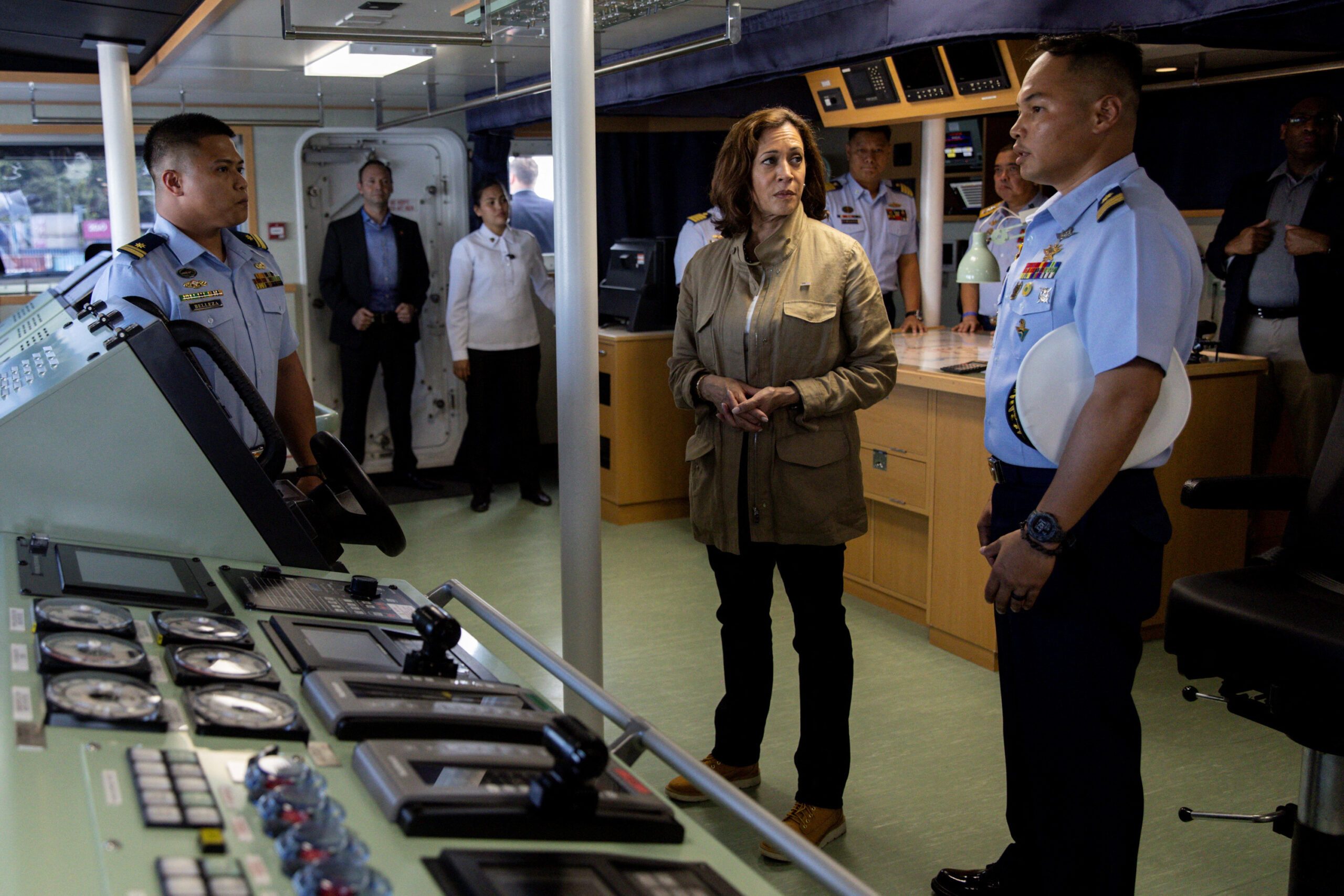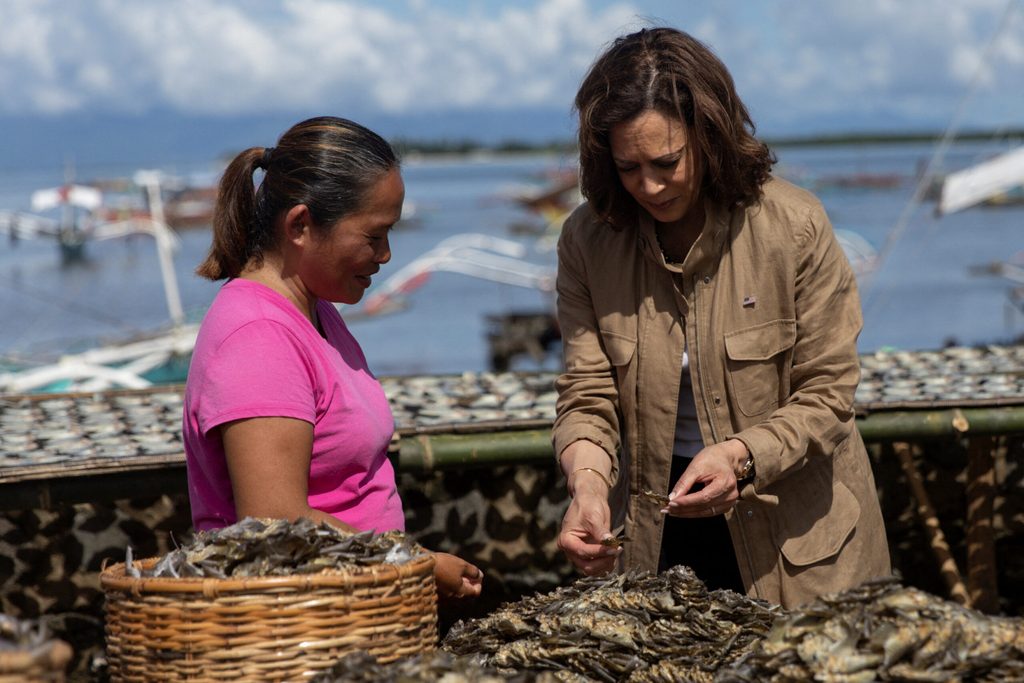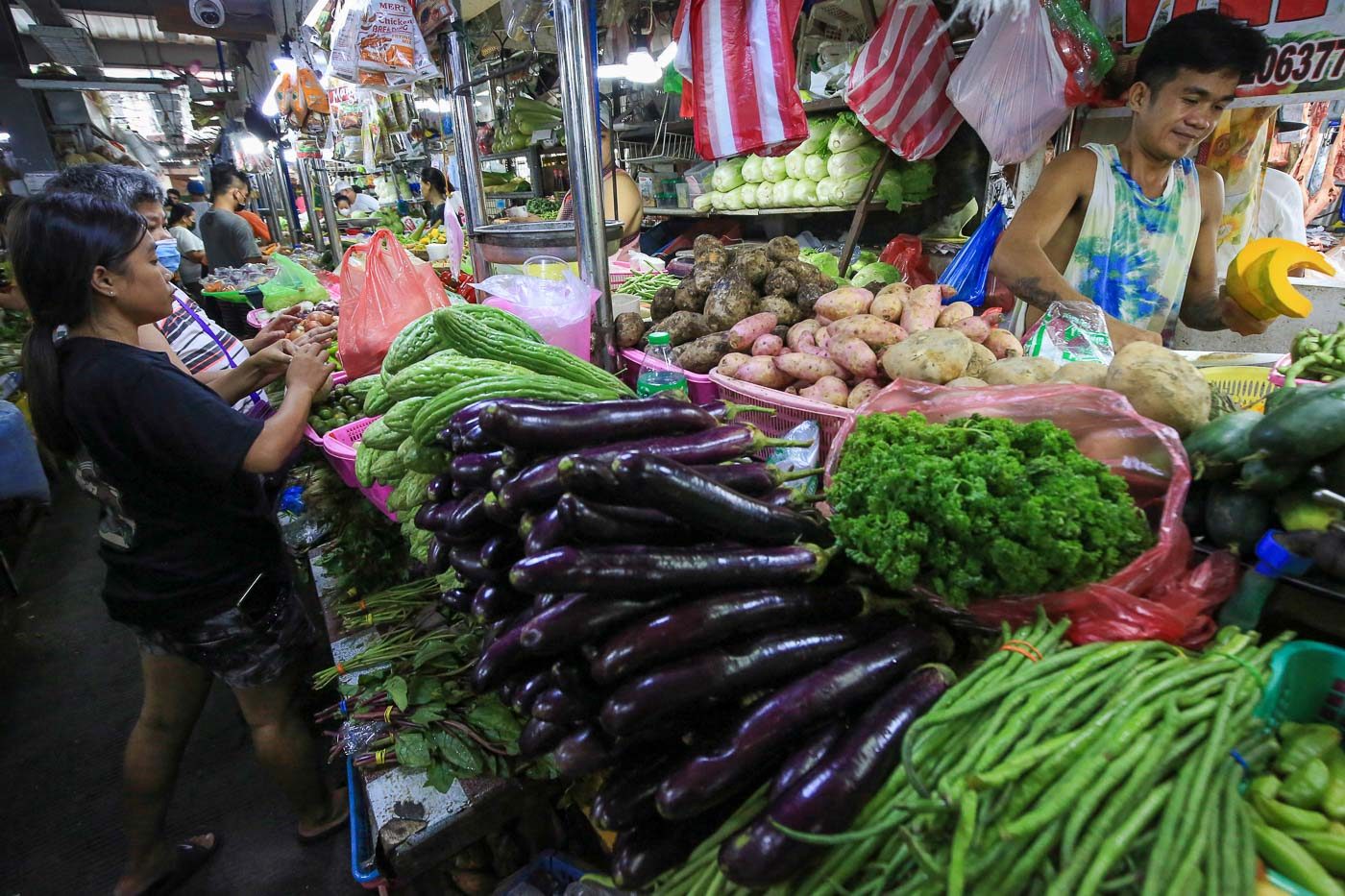SUMMARY
This is AI generated summarization, which may have errors. For context, always refer to the full article.

MANILA, Philippines – Just off the main road in Puerto Princesa Palawan, past a village town hall and down an unpaved road dotted with homes and fields, United States Vice President Kamala Harris spent an hour with residents of the local fishing community of Tagburos.
The American official was greeted with song and dance as she made her way past a basketball court, and down a narrow alley that opened up to a shoreline. Waiting to greet her were Filipino fishermen, who supplied nearly half of Puerto Princesa’s fish supply, and women of Tagburos, who for 15 years have made a living off danggit or dried fish.
“She told me she was proud of me,” said Jacqueline Relator, a resident of Tagburos. “I told her I worked at least 12 hours a day, and she was proud because I taught other women to dry fish like I do.” Harris, Relator said, later asked to take a basket of danggit – a gesture that Relator hoped would make it possible for her to sell danggit outside of Puerto Princesa.

For analysts and observers, Harris’ decision to tour a local community, as well as put in one-on-one time with its residents, served to show that the US remained a historic partner for the Philippines, despite coming under pressure from former president Rodrigo Duterte and his rancor toward Washington. With ties that bind the two countries not only in government, but in communities where American aid has been channeled, majority of Filipinos continue to express high levels of trust in the US.
Philippine President Ferdinand Marcos Jr. said as much, with his administration showing a desire to have ties with the US “evolve” and strengthened after fraying in recent years.
“I have said many times: I do not see a future for the Philippines that does not include the United States…. That really has come from the very long relationship that we have had with the US,” Marcos told Harris. “Of course, we went through different phases of a relationship. But since the war, it has just been strengthened in every way.”
Such messaging from Marcos, along with a slew of high-level visits from the US to the Philippines, carries more urgency as the new Marcos government seeks to tap its oldest ally in carving a path toward recovery from the pandemic while facing the challenges of responding to food and energy insecurity, as well as flaring tensions in the region.
For the US, efforts to shore up ties with Manila comes as it faces increased competition with China around the world, but especially in Southeast Asia, where for years, China has made headway in its diplomacy and economic assistance to the region.
Big wins
In the message presented by Harris’ visit, the US could serve as a reliable partner for the Philippines as it seeks to rebuild its economy which saw its worst dip since World War II during the pandemic.
Harris unveiled over 20 new initiatives launched during her visit, several of which were aimed at deepening economic cooperation with the Philippines. The issues likewise dominated a bilateral meeting between Marcos and Harris in Malacañang, along with proposed projects eyed in responding to climate change.
In particular, diplomatic sources said that the launch of negotiations on a civil nuclear cooperation agreement – known as a “123 agreement” in the US – was a big win for the Philippine government, which had eyed a more protracted timeline for the initiative.
While still a long way off from implementation, the start of talks on such an agreement brings the country one step closer to tapping costly nuclear power, which Marcos had wanted to revive as energy supplies dwindle in the country.
Energy Secretary Raphael Lotilla earlier warned yellow and red alerts are likely in 2023, with the Malampaya gas-to-power project set to expire in 2024. Gas from the projects accounts for some 40% of Luzon’s energy needs.
The inauguration of high-level dialogues on food and energy security were also viewed by analysts as significant, concrete outcomes of a bilateral meeting between Marcos and US President Joe Biden on the sidelines of the UN General Assembly in New York last September.

In what was an introduction for the two leaders who met in person for the first time, both Marcos and Biden spoke of forming technical working groups to usher the implementation of projects eyed to increase US investment in the Philippines.
Another project included US assistance toward the development of facilities in the Philippines that would refine nickel and cobalt – minerals essential in the transition to clean energy technology. The Philippines is home to one of the largest nickel reserves in the world and was China’s biggest nickel ore supplier, after Indonesia banned exports of the material from 2020 to try and develop its own full supply chain for the mineral.
Apart from this, the creation of a US Trade and Development Agency office in the US embassy in Manila saw officials from both countries optimistic that investments from American companies could come to fruition in the Philippines, especially as businesses seek to diversify supply chains and operations in Asia.
With a USTDA office in the Philippines, US firms interested in setting up or expanding shop in the Philippines could be matched with economic opportunities in Manila, officials said. Feasibility studies, often a bottleneck in infrastructure projects, could also receive funding and assistance from the USTDA which is tasked with building a pipeline of projects that will end in closed deals.
The roster of agreements was welcomed in diplomatic circles, whose members pointed to how the US was playing “catch up” not only in the Philippines, but also in the region, after years of being sidelined by previous American administrations.
In the Philippines alone, China remained the county’s largest trading partner and second largest export market. “It’s important for the United States to continue to step up its game,” Curtis Chin, chair of the Milken Institute Asia Center, told ANC.
“When we think about this region…the US, as China is doing, needs to focus on this region also as an economic and trade partnership in and of itself. It’s not just about the US-China relationship,” he added.
Message of commitment, strength
When it comes to the area of defense and security, many observers had expected the US to unveil additional assistance or announce the development of new sites under the two countries’ Enhanced Defense Cooperation Agreement (EDCA). The military deal, long-delayed under the Duterte government, allows the US military to construct facilities and preposition defense assets inside Philippine military bases.
Harris’ visit, however, only brought the announcement that additional funds would be channeled toward the completion of 21 ongoing projects under the agreement. New sites, although identified, were not yet disclosed.
Despite this, Julio Amador, president of the Foundation for the National Interest in the Philippines, said Harris’ trip was necessary for the old allies to sustain their current trajectory of improved ties.
“There are realizations in the US that its former colony and oldest ally in Asia deserves more recognition than it currently gets. It also shows how important geostrategically the Philippines is to US defense and security planning,” Amador said.
In particular, Harris’ visit to Palawan sent the message that the US was serious in committing to stand with the Philippines in upholding its sovereignty in the South China Sea, including the West Philippine Sea. The message was similar to that of previous senior US officials who visited the Philippines, but what set it apart was its delivery in Palawan, an island at the edge of the South China Sea.
The US vice president told Marcos that Washington had an “unwavering commitment” to defend the Philippines in case of an armed attack in the South China Sea. She also promised Filipinos in Palawan that the US was committed to protecting livelihoods that had been affected by “intimidation and coercion” in the disputed waterway.
“The United States and the broader international community have a profound stake in the future of this region. America’s prosperity relies on the billions of dollars that flow through these waters every day,” Harris said.
Philippines’ opportunity
Washington’s renewed attention to the Philippines, and its eagerness to start a new phase in ties with its oldest ally in Asia, shows that US officials are willing to address concerns the Philippines has raised when it came to nurturing the 75-year-old alliance.
But, Amador said: “Now that it has shown that it is willing to stand up for the interest of the Philippines, the question now is, what will Manila do with this alliance?”
Over the years, the Philippines-US alliance had become a relationship Manila celebrated but often “didn’t put much effort into,” Anna Patricia Saberon, a faculty member at the Ateneo de Naga University teaching international relations, told Rappler in an earlier interview.
Among investments experts pointed out that the Philippines needed included the modernization of its armed forces and defense equipment. “Yes, we like the Americans. Yes, we have these exercises. Yes, we have these partnerships. But in terms of really investing in the alliance, we’ve lacked,” Saberon said.
Amador added, “We can’t take our own importance too lightly.”
In January 2023, Marcos is scheduled to make a state visit to China, his first outside Southeast Asia.
Like the US, China has shown fervor in courting the Marcos administration, with whom it shares a warm history. It was under the presidency of Ferdinand E. Marcos, Marcos’ father and namesake, when the Philippines established diplomatic ties with China. – Rappler.com
Add a comment
How does this make you feel?












There are no comments yet. Add your comment to start the conversation.